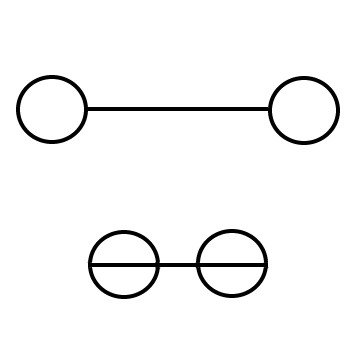pain, perception and perspectives
“You’re not seeing the world as it is, you’re seeing the world in terms of your ability to act.”
This is one of my favorite quotes in medical science and was made by Jessica Witt, professor for cognitive psychology. In the Müller-Lyer illusion shown in the title picture, perceived length can change by adding different arrows to the same line. Jessica Witt was involved in a lot of research showing how abilities influence our perception and we might get a clue how our perception has an influence on our behavioural decisions.
Here are some great examples to get a better understanding for her research:
- people that weight more judge distances further than people with less weight [1]
- softball players that hit the ball very often judged the ball bigger as it actually was, whereas those who kept missing underestimated the ball’s size [2]
- parcour runners judged the height of a wall more accurately than novice runners, who overestimated the height of the wall [3]
- low physical fitness makes a hill look steeper [4]
- chronic back or leg pain makes distances look further [5]
As I read about this topic I was really fascinated (again) from the complexity of our human body. I think this information can have some influence on our daily work with our patients.
We know that exercise therapy can have positive effects in our patients. These effects are often described in different physical adaptions like gaining strength [6] or muscle mass [7], increasing the production of opioids in the central nervous system [8] or anti-inflammatory changes in the immune system [9]. But those mechanical adaptions seem to play an inferior role in achieving a positive clinical outcome [10].
Now according to the perception-research mentioned above we should also think about the cognitive-evaluative perspective when prescribing exercise as therapy. If we consider that people see the world differently it is reasonable to say that they make different decisions according to their perception. Eves et al. [11] have shown that in a great experiment in 2014: pedestrians were recruited from those who chose the stairs or those who avoided them by taking the escalator. They asked 229 people to estimate the steepness of a life-sized image of the stairs they had just encountered, presented on the wall of a vacant shop in the mall. Pedestrians who avoided stair climbing by choosing the escalator reported the stairs as steeper as the group of pedestrians taking the stairs.
If we consider that some patients reduce their activity because of overestimating a task and underestimating their abilities, it would be reasonable to think that challenging their perceptions of their environment should be a target of our therapy. This is the point where I see the practical implications on exercise therapy in that fabulous quote of Jessica Witt.
Besides targeting certain muscles with exercises, we should also practice the tasks our patients are afraid of to (re-)shape their perception. In some situations, it makes sense to modify the environment during a task just to create a "new" or different context for the patient. If the task would be walking for 500 meters some modifying ideas could be:
- walking forward/backward with extra weight from a pulley system (patient love this exercise, because they feel some much lighter after removing the weight ;) )
- walking in a swimming pool
- walking with closed eyes
As a take-away of this blog we should keep in mind that some patients avoid activities because they might underestimate their abilities for this activity. We should therefore integrate those activities in our active rehabilitation to (re-)shape their perception and change their decision-making by a more accurate estimation of their abilities. Always respect that your patient see's the world a little different than you ;)
Thanks for reading,
Sebastian
[1] Sugovic M, Turk P, Witt JK. Perceived distance and obesity: It's what you weigh, not what you think. Acta Psychol (Amst). 2016 Mar;165:1-8.
[2] Witt JK, Proffitt DR. See the ball, hit the ball. Psychol Sci. 2005 Dec;16(12):937-8.
[3] Taylor JE, Witt JK, Sugovic M. When wall are no longer barriers: perception of wall height in parkour. Perception. 2011;40(6):757-60.
[4] Bhalla M, Proffitt DR. Visual-motor recalibration in geographical slant perception. J Exp Psychol Hum Percept Perform. 1999 Aug;25(4):1076-96.
[5] Witt JK, Linkenauger SA, Bakdash JZ, Augustyn JS, Cook A, Proffitt DR. The long road of pain: chronic pain increases perceived distance. Exp Brain Res. 2009 Jan;192(1):145-8.
[6] Steele J, Fisher J, Perrin C, Conway R, Bruce-Low S, Smith D. Does change in isolated lumbar extensor muscle function correlate with good clinical outcome? A secondary analysis of data on change in isolated lumbar extension strength, pain, and disability in chronic low back pain. Disabil Rehabil. 2018 Jan 12:1-9.
[7] Choi G, Raiturker PP, Kim MJ, Chung DJ, Chae YS, Lee SH. The effect of early isolated lumbar extension exercise program for patients with herniated disc undergoing lumbar discectomy. Neurosurgery. 2005 Oct;57(4):764-72
[8] Sluka KA, O'Donnell JM, Danielson J, Rasmussen LA. Regular physical activity prevents development of chronic pain and activation of central neurons. J Appl Physiol (1985). 2013 Mar 15;114(6):725-33.
[9] Leung A, Gregory NS, Allen LA, Sluka KA. Regular physical activity prevents chronic pain by altering resident muscle macrophage phenotype and increasing interleukin-10 in mice. Pain. 2016 Jan;157(1):70-9.
[10] F. Steiger, B. Wirth, E. D. de Bruin, and A. F. Mannion. Is a positive clinical outcome after exercise therapy for chronic non-specific low back pain contingent upon a corresponding improvement in the targeted aspect(s) of performance? A systematic review. Eur Spine J. 2012 Apr; 21(4): 575–598.
[11] Eves FF, Thorpe SK, Lewis A, Taylor-Covill GA. Does perceived steepness deter stair climbing when an alternative is available? Psychon Bull Rev. 2014 Jun;21(3):637-44.
#pain #perception #chronicpain #painscience #manualtherapy #musculoskelettaltherapy #maitland #imta #sebsebsen #löscher





Comments